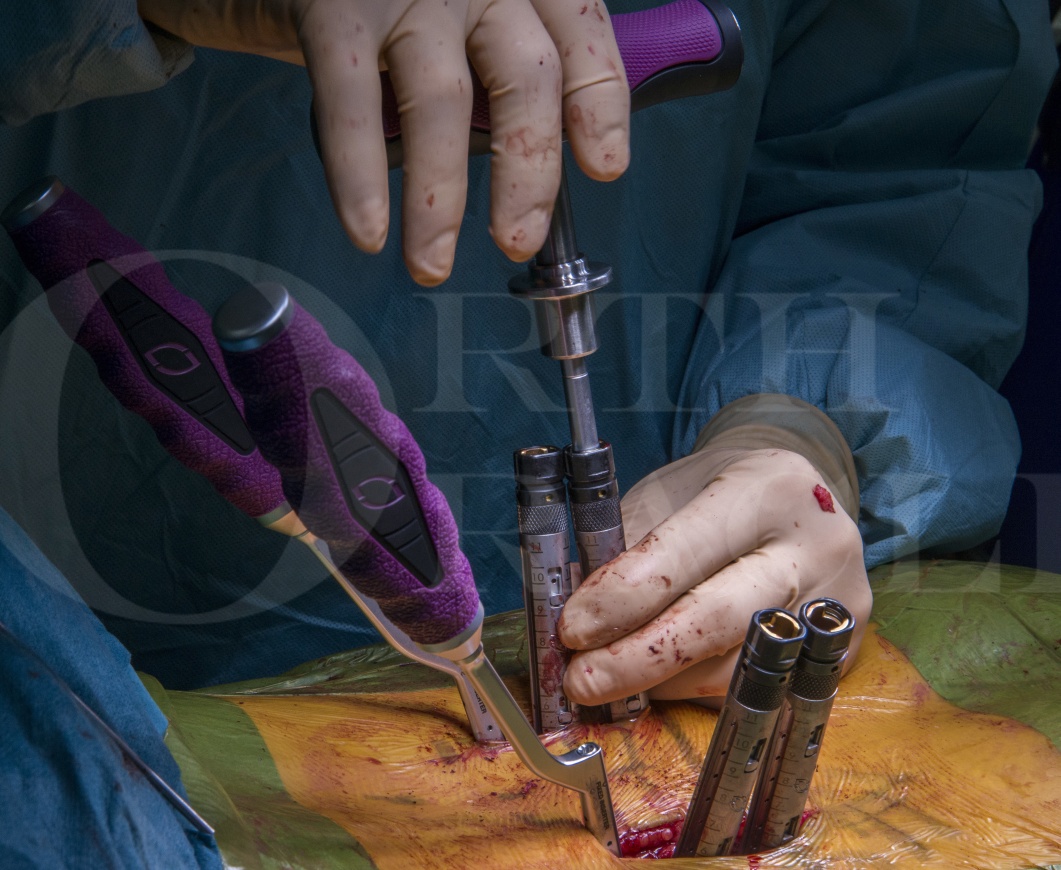Minimally Invasive Transforaminal Lumbar L5/S1 Interbody Fusion using Nuvasive pedicle screws, MAS retractor and Stryker OIC PEEK cage
Overview

Subscribe to get full access to this operation and the extensive Spine Surgery Atlas.
Learn the Minimally Invasive Transforaminal Lumbar L5/S1 Interbody Fusion using Nuvasive pedicle screws, MAS retractor and Stryker OIC PEEK cage surgical technique with step by step instructions on OrthOracle. Our e-learning platform contains high resolution images and a certified CME of the Minimally Invasive Transforaminal Lumbar L5/S1 Interbody Fusion using Nuvasive pedicle screws, MAS retractor and Stryker OIC PEEK cage surgical procedure.
The Transforaminal Lumbar Interbody Fusion (TLIF) allows both direct and indirect decompression of the lumbar spine as well as its stabilisation. It involves the insertion of screws and rods for posterior stabilisation and anterior fusion in the disc space through cage placement. It is an alternate procedure to the Posterior Lumbar Interbody Fusion (PLIF). The TLIF involves a complete facetectomy which facilitates a more lateral disc space approach and therefore less neural retraction than the PLIF. A PLIF involves fusion cage placement from within the canal after a medial partial facetectomy and neural retraction to expose the disc space through a standard posterior approach.
The Minimally Invasive Surgery (MIS) TLIF involves limited exposure and whilst this has potential benefits, compared to an open approach, such as minimal muscle trauma, less bleeding, shorter hospital stays and quicker return to function. It must be noted than identification of the anatomy remains key and is more challenging and the interbody cage becomes the only site at which fusion can occur so the surgical technique must be meticulous.
The MIS TLIF can be performed in several ways although there are certain key steps which are broadly similar irrespective of the exact technique.
Polyaxial pedicle screws are inserted percutaneously after entry points have been identified, using Image Intensifier, at the junction of the transverse process and the lateral facet. A paraspinal (Wiltse) approach is used rather than a midline approach. The inferior pedicle is skeletonised and the disc space is approached obliquely from the foramen. The pedicle screws can provide a point of distraction if required. Complete and thorough discectomy is meticulously undertaken before insertion of graft material and an interbody cage.
The technique detailed is an MIS TLIF procedure utilising the Nuvasive Precept pedicle screw system and the Nuvasive MAS retractor. The MIS TLIF procedure is technically demanding and intricate. It will initially result in longer operative times due to the learning curve but these come down as confidence is gained. Appropriate instrumentation, and appropriate consents, should always be in place should it become necessary to convert to an open procedure.
The Nuvasive system is well designed and easy to use but it is always advisable to have representative support from the company. It has appropriate clinical data to support its efficacy and safety.
This technique also demonstrates the use of the the Stryker OIC PEEK cage here. It has a choice of lengths and heights that are sized and chosen intraoperatively. It is a simple design of a spacer with central hole to accept bone graft.
Author: Mr Andrew Young FRCS (Tr & Orth)
Institution: The Royal Orthopaedic Hospital, Birmingham, UK.
Clinicians should seek clarification on whether any implant demonstrated is licensed for use in their own country.
In the USA contact: fda.gov
In the UK contact: gov.uk
In the EU contact: ema.europa.eu
Online learning is only available to subscribers.



















